What is freesia and how to grow it?

Freesia is a beautiful bulbous plant that is grown both outdoors and in pots. It is not easy to keep it, but if you follow the recommendations of experienced flower growers, freesia will definitely delight a person with its long flowering and pleasant aroma.

general description
This exotic flower is native to South Africa. In nature, it is found on the banks of rivers and lakes. The plant was named after the botanist who first discovered it. Popularly, this flower is also often called the Cape lily of the valley.
The plant has a low growth rate. On average, the flower grows up to 30-80 centimeters. The stems of the plant are bare. Freesia foliage doesn't look particularly remarkable. Many people note that it looks like the foliage of garlic. In the spring, inflorescences appear on the stems. They can consist of 3-5 colors. Most often, white buds are found. But there are also varieties of freesia in nature with lilac, pink or purple flowers.
The Cape lily of the valley is actively used by florists to compose various bouquets. Flower arrangements with this plant look very delicate and beautiful. Besides, freesia smells very nice... Therefore, it is very pleasant to store bouquets with such spring flowers.
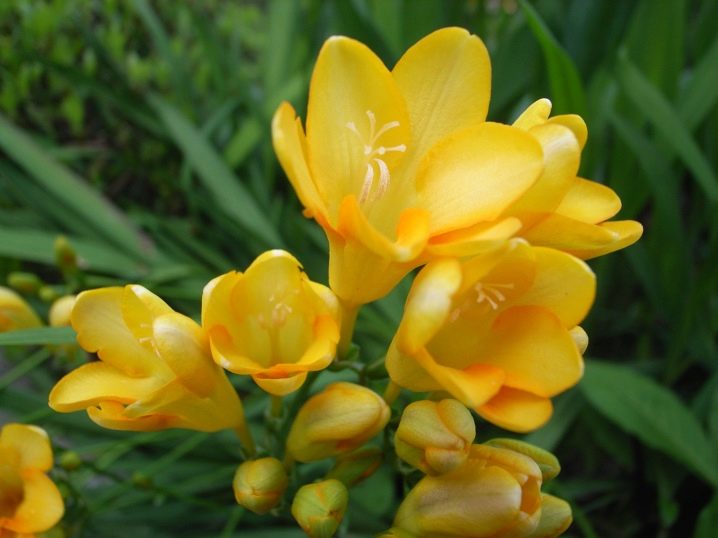
Views
Since the 19th century, breeders have been actively developing new varieties of freesia. The most popular now are the following flower varieties.
- Terry... This flower grows up to a meter in height. Its foliage is wide and dark green. The flower stalks of terry freesia are quite large. The color of their petals can be pink, yellow and blue. One of the most popular varieties of such freesia is Double Mix.
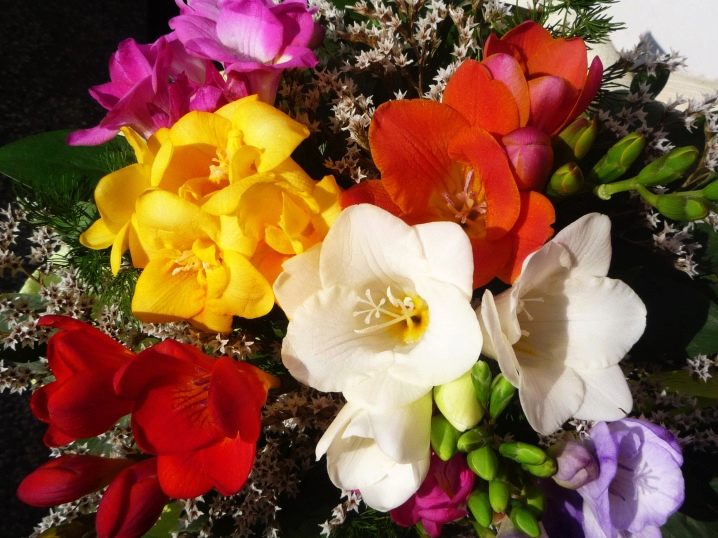
- Freesia Armstrong... This type of freesia has red buds combined into large inflorescences. They appear on the plant at the end of May. The most popular variety of such freesia is Cardinal.
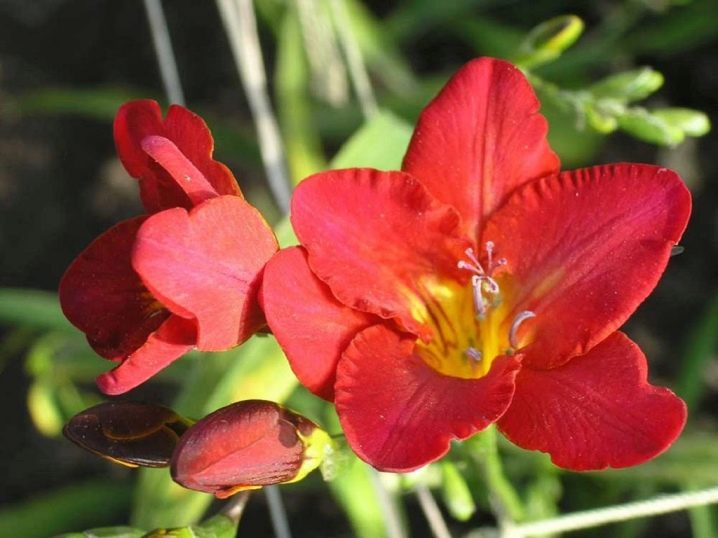
- Broken... This is a very short plant. In height, it grows up to 30-40 centimeters. Its stems are branched, and the flowers are yellow or orange in color. This freesia blooms in the middle of spring. When planting this flower in your area, it is worth remembering that it has very weak stems. Therefore, the plant needs a garter.

- Hybrid... This plant was obtained by crossing Armstrong Freesia and Broken. The bushes grow to a height of 50-60 centimeters. The flowers of the plant are not very large. But one inflorescence can consist of 9-10 buds. The petals of this freesia can be either smooth or double. Plants with lilac or purple flowers are the most popular.
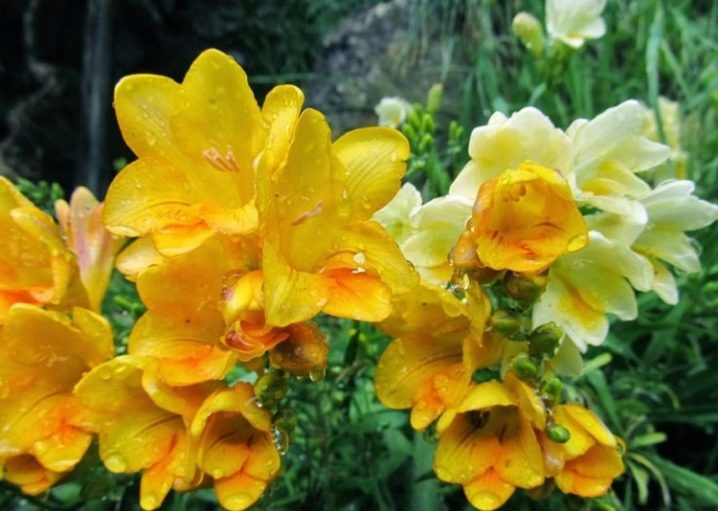
All of these varieties of spring flowers can be easily found commercially.
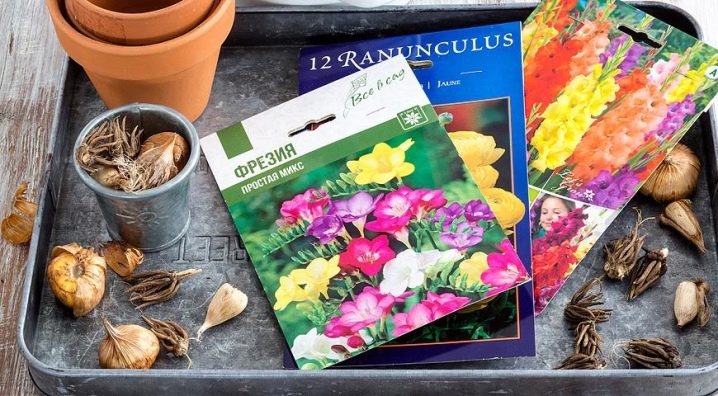
Landing
For planting a delicate exotic flower, it is important to choose high-quality soil. Cape lily of the valley grows best in loose and nutritious soil. Before planting freesia, a small amount of compost is embedded in the ground. Flowers that are grown indoors must be planted in a special substrate for roses. It can be found in most gardening stores.
When choosing a landing site, preference should be given to shaded areas. Cape lily of the valley grows best in the shade of shrubs or trees. The plant should not be exposed to direct sunlight. This is bad for his health.
The quality of the planting material also plays an important role. All bulbs selected must be healthy. They cannot have any traces of rot or mold. Before planting, they can be placed for half an hour in a container with a weak solution of potassium permanganate or "Fitosporin". If the planting material is not pre-processed, freesia will not germinate.
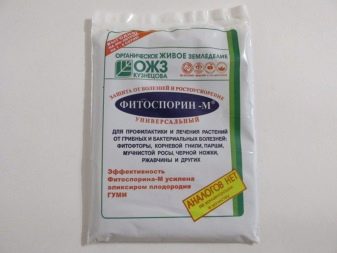
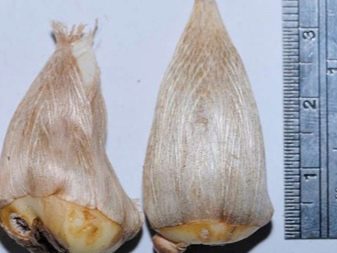
After pretreatment, you can start planting the bulbs in the soil. This process consists of the following steps.
-
To begin with, the soil on the site must be carefully loosened... Next, you need to dig several deep holes in it. The distance between them should be within 10 centimeters.
-
After that, the bulbs are placed in the wells.... Sprinkle them on top with loose soil.
-
Further, the beds are watered abundantly. Water for irrigation should be used standing.
Planting freesia is best in the evening.
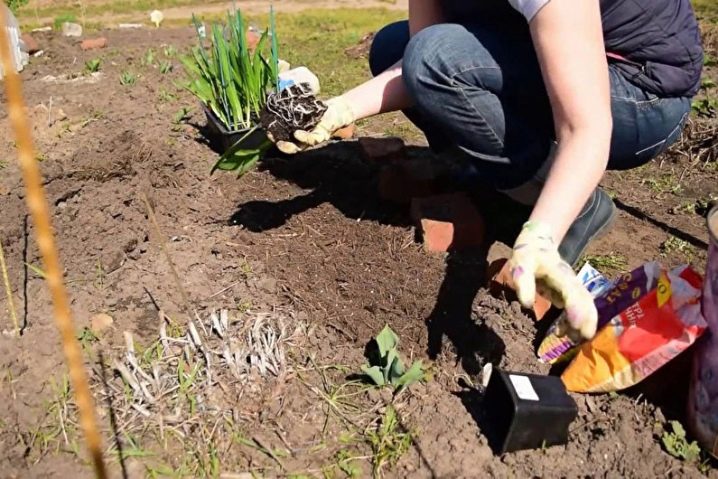
Growing care
Growing beautiful freesias at home is pretty easy. Agricultural technology of Cape lily of the valley consists of the following procedures.
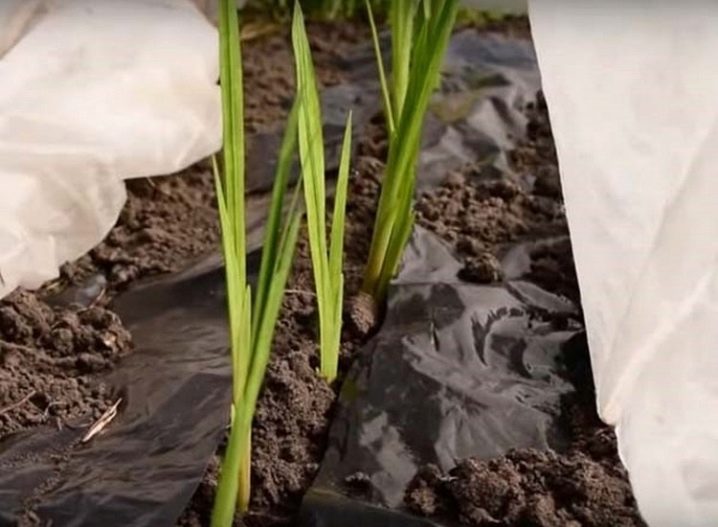
Watering
First of all, it is important for plants to ensure proper watering. Young flowers are watered 1-2 times a week. The frequency of watering adult plants depends on the weather conditions. The soil is moistened as it dries.
You need to water the plants at the root. Do not allow water to enter the buds. This will lead to the loss of the attractiveness of the plant.
Particular attention should be paid to watering in the heat. But after the end of the flowering period, watering begins to be reduced. At this time, the flower is already preparing for wintering.
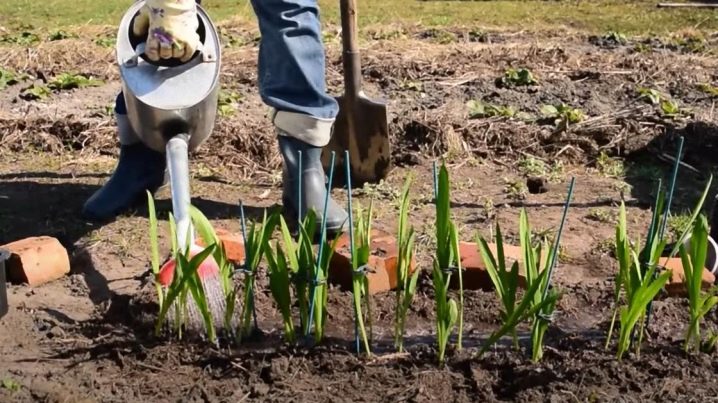
Top dressing
In the spring, freesia is fed with fertilizers containing nitrogen. This helps the flower to form stems and green foliage. During the flowering period, gardeners use superphosphate and potassium salt.
You can only feed freesia with liquid fertilizers. Dry products are not added to the soil.
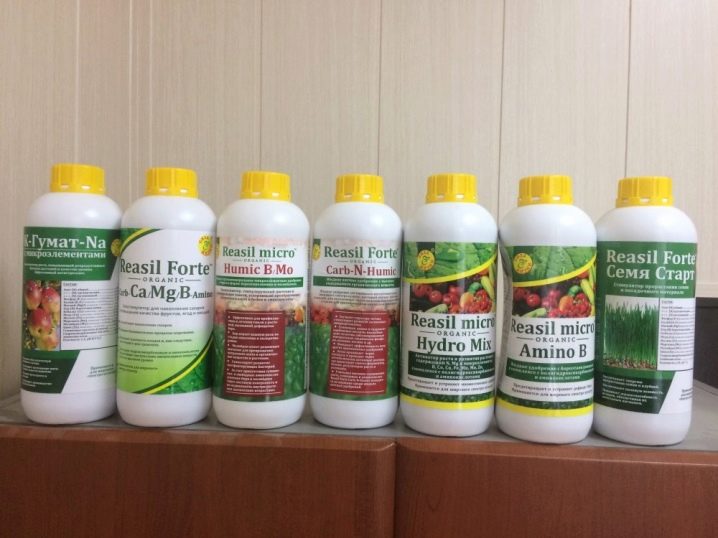
Pruning
This treatment helps to stimulate Cape Lily of the Valley re-flowering. Pruning is carried out after the freesia buds wilted. The foliage of the plant can also be removed. This is done after it changes its color to brown or yellow.

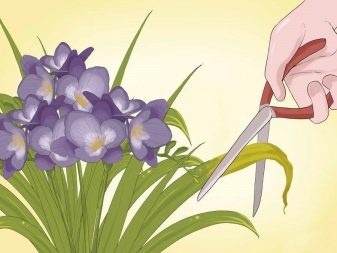
Wintering
Freesia is an exotic perennial. After the end of flowering, the corms are dug up. The next year they are planted again.
You can dig up the bulbs after the freesia has faded. Immediately after that, they are transferred to a well-ventilated place and left to dry there for 10-15 days. Then the bulbs are cleaned of dirt and sent to the basement or any other cool place for the winter. They are stored there until spring.
Indoor flowers should always be in a well-lit room.
In winter, freesia is recommended to be additionally highlighted.
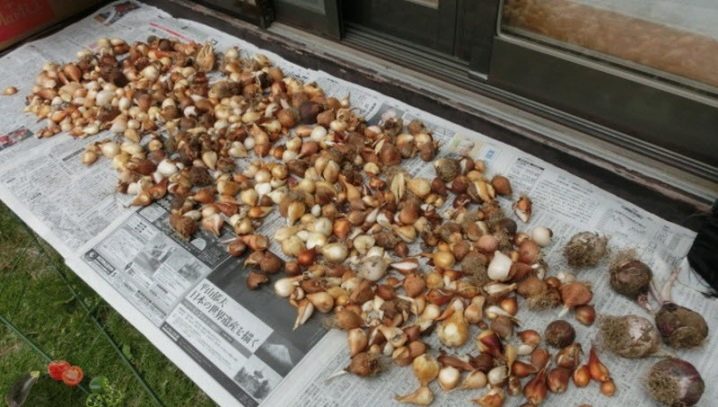
Reproduction
For propagation of freesia, you can use not only corms, but also seeds. The process of growing flowers from seeds is as follows.
-
To begin with, the planting material is soaked in water. They do this within a day.
-
The seeds prepared in this way are planted in containers with a loose substrate. They should be located at a depth of 1-2 centimeters.
-
Sprinkle the seeds on top with a layer of soil. It should be thin. If the freesia does not emerge, it is likely that the seeds have been covered with too much soil.
-
Next, the containers are covered with a transparent film. In such greenhouse conditions, freesia grows quite quickly.
-
In the future, containers with seeds are ventilated twice a day. The soil in the container must not dry out. For this reason, it is regularly sprayed with a spray bottle.
-
When the first seedlings appear in the container, the container will need to be placed on the windowsill.

It will be possible to transplant flowers into open ground after they grow up.
Disembarkation time depends on local climate. So, in the southern regions of the country, plants begin to be planted in March.
In the Urals and in other cold cities - in the second half of spring.
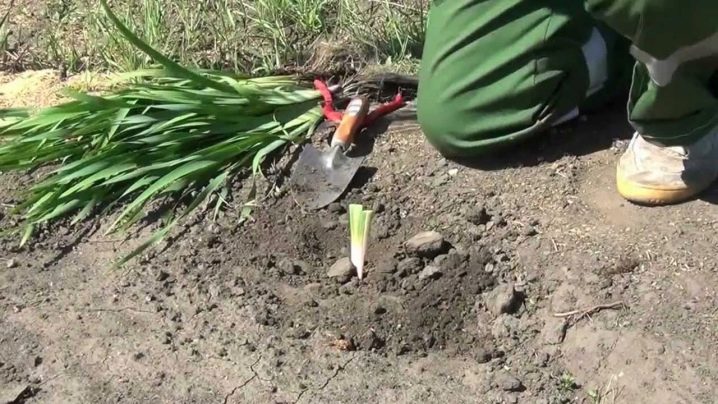
Diseases and pests
Freesias growing in the garden or in the house can be affected by the following diseases.
- Fusarium... This disease is also called fusarium wilt. In diseased plants, the foliage turns yellow first.Freesia stems dry up and the root system dies. Brown spots appear on the bulbs. You can save the plants by treating the flowers with the infusion of wood ash. If a folk remedy does not work, you can use proven fungicides.

- Gray rot... The foliage and shoots of infected plants are covered with a gray, fluffy bloom. The shape of these spots can be different. The development of the disease is facilitated by sudden changes in temperature and high humidity. To make the flowers hurt less often, they should not be planted too close to each other.
If the disease has already struck the plant, it must be sprayed with a preparation called "Skor".
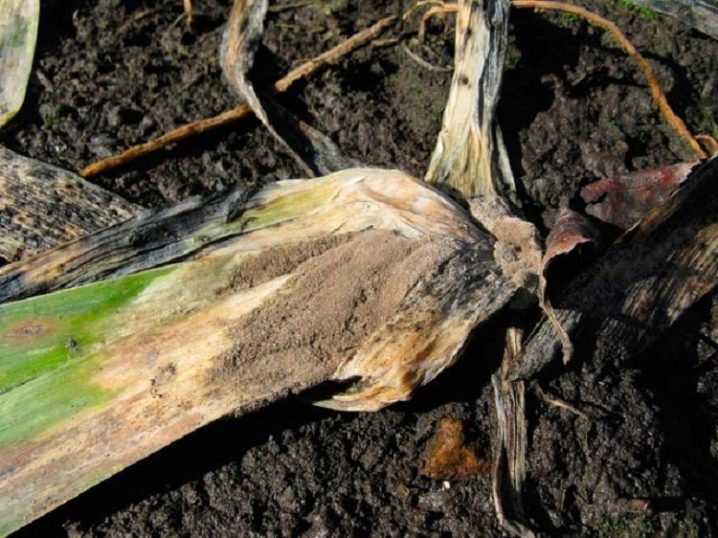
- Black spot. This disease manifests itself as a result of a lack of potassium or phosphorus. The foliage of diseased plants is covered with brown spots. In order to prevent the development of the disease, the flowers are fed with mineral fertilizers. If the plant is still sick, it should be removed from the site and destroyed, and the soil at the site should be treated with any disinfectant. A similar treatment is done as a preventive measure immediately after the freesia has sprung up.
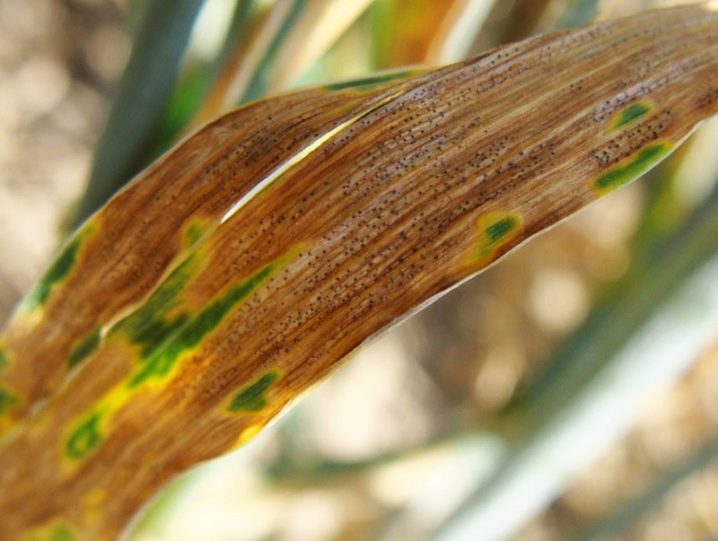
Small pests can also pose a danger to flowers. Most often, freesias growing in the garden attack thrips or aphids. To combat them, you can use a regular soap solution. If that doesn't work, the grower can spray the area with any potent insecticide.
Overall, freesia is an attractive plant that can beautify any area. By adhering to simple rules, you can easily achieve long-lasting flowering of this amazing spring plant.








































































































The comment was sent successfully.